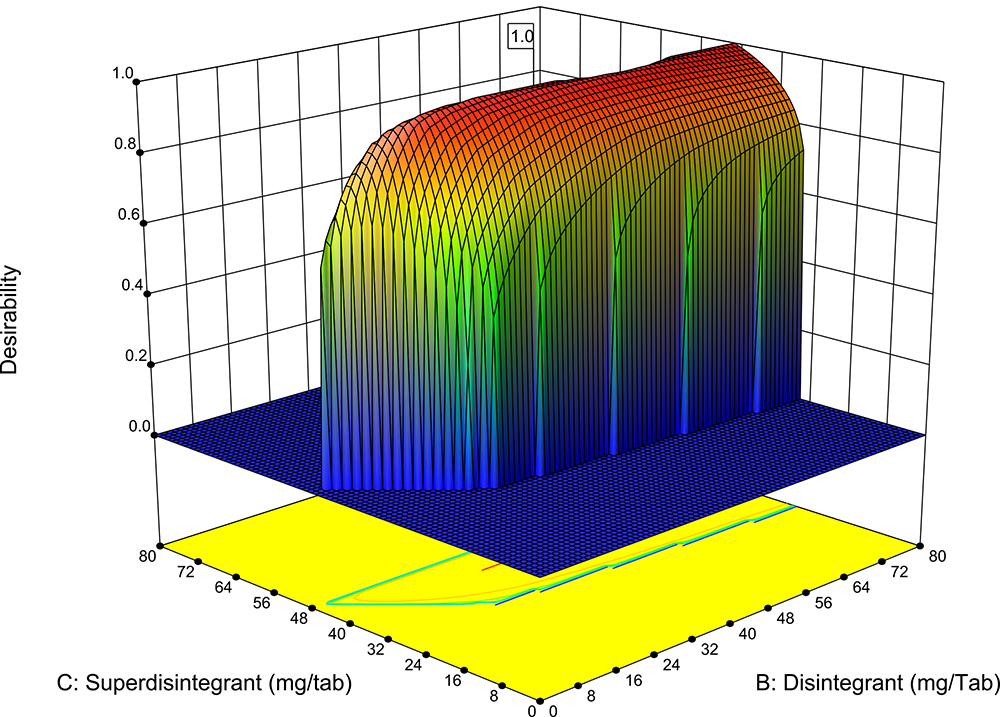
Prediction function generated by Design-Expert indicates the concentration of each variable required to meet all of the target dissolution values. (Credit: VerGo)
VerGo Pharma Research Laboratories Pvt. Ltd was recently hired by a generic pharmaceutical manufacturer to develop a bioequivalent with different polymorphic forms for an anti-depressant drug that had been patented in crystalline form only. Bioequivalence requires that a drug be pharmaceutically equivalent and that it be delivered at the same rate and same level of bioavailability so that its efficacy and safety can be expected to be the same as the original product.
In this formulation development application, a number of generic drug producers had worked with other contract research companies who had been able to achieve the right concentration of the drug in the blood of volunteer patients in the fed condition but were not able to achieve the right concentration in the fasting condition.
We speculated that the reason the other contract researchers were not able to find the right formulation is that they were testing the effects of one ingredient at a time and were thus missing potential effects caused by interactions between ingredients. We turned to Design of Experiments (DOE) because it is specifically intended to identify interactions between process variables. We selected Design-Expert® software from Stat-Ease, Inc., Minneapolis, Minnesota, because it offers such a wide range of experimental designs and because it makes it easy for a user without a statistical background to design an experiment and analyze the results
Design-Expert software was used to design an optimal experiment with three factors, each consisting of the concentration of an inactive ingredient, an insoluble diluent, a mild disintegrating agent and a super-disintegrating agent. The software selected values for a total of 20 runs with the diluent ranging from 0 to 194 milligrams per tablets and the two disintegrating agents ranging from 0 to 80 mg per tablet. We took the above-mentioned compositions provided by the software and produced the tablets for each experiment while keeping the manufacturing process parameters constant. The dissolution of each tablet was measured in the lab at 1.6 pH at 20, 45 and 90-minute levels and at 5.5 pH at 20 and 45 minutes. The results were entered into the software along with the ideal values for the dissolution rate at each pH value/time point pair. These dissolution rate values were selected to match the values achieved by the original drug based on the assumption that if the proposed generic performs the same as the original drug in the lab it is likely to also perform the same in clinical testing.
The software generated a prediction of the concentration of each variable required to meet all of the target dissolution values. VerGo scientists then prepared a new batch of tablets with the recommended concentration values. These tablets matched the desired dissolution profile within +/- 5 percent, which is within the acceptable margin of error. We also decided to test the proposed pharmaceutical in the presence of two surfactants that are present in the human body with the goal of ensuring its performance in clinical testing. We found that the surfactants speeded up the dissolution profiles of the test formulation as compared to the reference formulation. Hence, we reduced the value of the super-disintegrant in order to reduce the dissolution profile back to the target value. We used the sensitivity of the formulation to the super-disintegrant as determined by the designed experiment and, in fact, reducing the surfactant by the amount suggested by the software had the desired effect of hitting the target dissolution profile within +/- 5 percent with the surfactants present.
The next step was preparing a larger batch of tablets with this formulation for use in clinical testing with volunteer patients. The patients took the drugs in both fed and fasting conditions and the concentration of the drug in their blood was measured at set intervals. The results showed that
VerGo was the first company that was able to match the blood concentration levels of the active ingredient to the original pharmaceutical over the full time profile. This project was successfully completed in four months compared to two years for similar projects which were undertaken without the benefit of DOE.
Subrata Kundu, Ph.D, is a Principal Scientist at VerGo Pharma Research Laboratories in South Goa, Goa, India, a position he has held since March 2011. VerGo Pharma Research provides comprehensive analytical services in chemistry to a broad spectrum of clients in the pharmaceutical, biotech, and chemical industries. Among its services are formulation development, analytical method development and validation, drug substance and drug product stability testing, custom synthesis and raw materials qualification and testing.




